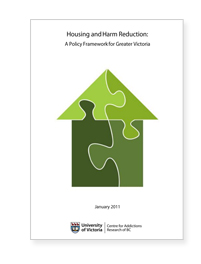Many jurisdictions in Canada have begun to recognize the value of harm reduction and have developed innovative and effective programs to deal with the harms of substance use and addiction. For example, there are over 30 studies that support the effectiveness of Insite, Vancouver’s supervised injection site, as reducing the harm associated with injection drug use. Harm reduction works because it gives people choice, counters stigma associated with drug use, acknowledges that drug use is part of our history as a society, and that reducing harms instead of eliminating use can make people and communities safer and healthier. Recognizing the value of harm reduction can be seen in the inclusion of harm reduction in strategies related to mental health promotion and addictions care as well as public health programs and services oriented to preventing the harms of substance use. However, there has not been much discussion of the role harm reduction plays in ending homelessness.
Harm reduction is a key principle of Housing First programs. Housing First separates the right to housing from conditions such as acceptance of treatment or sobriety. Recently, the Greater Victoria Coalition to End Homelessness contracted Scientists at Centre for Addictions Research of British Columbia to develop a paper that outlines the role of harm reduction as part of a strategic plan to end homelessness. The cornerstones of this policy framework are social inclusion and the provision of permanent affordable housing. Permanent housing is essential to reducing the harms of homelessness and substance use. For example, lack of housing increases the harms of substance use including the risk of blood borne diseases and premature death. The need for permanent affordable housing and policies of client inclusion in the development of policies and programs are complemented by a series of six other strategic directions that outline the necessary elements of a housing and harm reduction strategy.
This framework recognizes that ‘one size does not fit all’ and that a variety of approaches are needed in the provision of housing and supports. A housing and harm reduction policy framework includes a range of housing options that place client choice at the center. The proposed policy framework widens the range of housing options to include low barrier housing where drugs and alcohol are tolerated to living in buildings where alcohol and drug use is prohibited. Low-barrier housing has the same requirements of tenants in any other rental situation: pay the rent, don’t destroy property and don’t behave in ways that will harm or disturb other tenants. The framework recommends a number of options for integrating housing and harm reduction. For example: the Dr. Peter Centre in Vancouver has integrated harm reduction philosophy and services such as supervised injection into the provision of housing and supports for people with HIV/AIDS and injecting drug use. Community harm reduction services are important for those living in market housing.

The strategies recommended in the frame work are consistent with current evidence and have been shown in other cities to reduce the harms of drug use as well as health and social costs. For example, the provision of low barrier housing to people with long term chronic homelessness and alcohol problems significantly reduced, health, policing, social service and justice costs in Seattle. A policy framework is an initial first step and it plays a role in bringing people together around new understandings of what we ought to do. The next step is doing the right things for citizens and communities.
To access the full policy framework, see: Housing and Harm Reduction: A Policy Framework for Greater Victoria
Bernie Pauly RN, Ph.D is an Associate Professor in the School of Nursing and a Scientist in the Centre for Addictions Research of BC at the University of Victoria.

